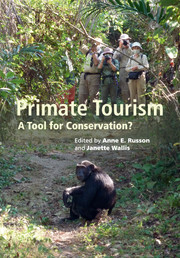Book contents
- Frontmatter
- Contents
- List of contributors
- Part I Introduction
- Part II Asian primates
- Part III African primates
- Part IV Neotropical primates
- Part V Broader issues
- 15 Economic aspects of primate tourism associated with primate conservation
- 16 Considering risks of pathogen transmission associated with primate-based tourism
- 17 Guidelines for best practice in great ape tourism
- Part VI Conclusion
- Index
- References
15 - Economic aspects of primate tourism associated with primate conservation
from Part V - Broader issues
Published online by Cambridge University Press: 05 September 2014
- Frontmatter
- Contents
- List of contributors
- Part I Introduction
- Part II Asian primates
- Part III African primates
- Part IV Neotropical primates
- Part V Broader issues
- 15 Economic aspects of primate tourism associated with primate conservation
- 16 Considering risks of pathogen transmission associated with primate-based tourism
- 17 Guidelines for best practice in great ape tourism
- Part VI Conclusion
- Index
- References
Summary
Introduction
This chapter considers primate tourism as a form of wildlife tourism, that is tourism based on encounters with non-domesticated animal species (Higginbottom, 2004), stressing encounters in their natural environment and intended to be non-consumptive. The rapid growth of wildlife tourism around the world is influenced by many different groups, including tourists, tour operators, local communities, conservation organizations, and governments. These groups are involved for a variety of motives, including recreational enjoyment, business development, community development, protection of wildlife and their habitats, and tax revenues.
All these motivations have economic aspects (Lindberg, 2001). Consider a few examples. Recreation enjoyment is substantial and can be valued monetarily; such benefits can rival or exceed those of other types of land uses. Tourist expenditures can stimulate local development, such as transportation or communications infrastructure, that can benefit local residents and tourists. Tourism revenues can raise funds for wildlife conservation projects, provide local residents with alternatives to less sustainable resource uses, and support governmental and non-governmental educational goals. Tourism-related businesses can support various levels of government by generating tax revenues, and businesses that receive tourist expenditures will, in turn, re-spend some of that money in the local region. Other economic benefits from wildlife tourism include local employment, industry stimulation, economic diversification, and infrastructure improvements (McNeely et al., 1991). On the other hand, economic costs result from wildlife tourism, notably in establishing and controlling tourist facilities and services. They may grow if, for example, tourist expenditures increase inflation or tourist activities harm the wildlife, natural habitats, or regions visited.
- Type
- Chapter
- Information
- Primate TourismA Tool for Conservation?, pp. 259 - 277Publisher: Cambridge University PressPrint publication year: 2014
References
- 3
- Cited by



